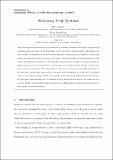| dc.contributor.author | Johnson, Kristine Dianne | |
| dc.contributor.author | Simchi-Levi, David | |
| dc.contributor.author | Sun, Peng | |
| dc.date.accessioned | 2014-09-16T19:27:27Z | |
| dc.date.available | 2014-09-16T19:27:27Z | |
| dc.date.issued | 2014-06 | |
| dc.date.submitted | 2013-10 | |
| dc.identifier.issn | 0030-364X | |
| dc.identifier.issn | 1526-5463 | |
| dc.identifier.uri | http://hdl.handle.net/1721.1/89651 | |
| dc.description.abstract | Scrip systems provide a nonmonetary trade economy for exchange of resources. We model a scrip system as a stochastic game and study system design issues on selection rules to match potential trade partners over time. We show the optimality of one particular rule in terms of maximizing social welfare for a given scrip system that guarantees players' incentives to participate. We also investigate the optimal number of scrips to issue under this rule. In particular, if the time discount factor is close enough to one, or trade benefits one partner much more than it costs the other, the maximum social welfare is always achieved no matter how many scrips are in the system. When the benefit of trade and time discount are not sufficiently large, on the other hand, injecting more scrips in the system hurts most participants; as a result, there is an upper bound on the number of scrips allowed in the system, above which some players may default. We show that this upper bound increases with the discount factor as well as the ratio between the benefit and cost of service. Finally, we demonstrate similar properties for a different service provider selection rule that has been analyzed in previous literature. | en_US |
| dc.description.sponsorship | Masdar Institute of Science and Technology | en_US |
| dc.description.sponsorship | National Science Foundation (U.S.) (Contract CMMI-0758069) | en_US |
| dc.language.iso | en_US | |
| dc.publisher | Institute for Operations Research and the Management Sciences (INFORMS) | en_US |
| dc.relation.isversionof | http://dx.doi.org/10.1287/opre.2014.1260 | en_US |
| dc.rights | Creative Commons Attribution-Noncommercial-Share Alike | en_US |
| dc.rights.uri | http://creativecommons.org/licenses/by-nc-sa/4.0/ | en_US |
| dc.source | Other univ. web domain | en_US |
| dc.title | Analyzing Scrip Systems | en_US |
| dc.type | Article | en_US |
| dc.identifier.citation | Johnson, Kris, David Simchi-Levi, and Peng Sun. “Analyzing Scrip Systems.” Operations Research 62, no. 3 (June 2014): 524–534. | en_US |
| dc.contributor.department | Massachusetts Institute of Technology. Engineering Systems Division | en_US |
| dc.contributor.department | Massachusetts Institute of Technology. Operations Research Center | en_US |
| dc.contributor.department | Sloan School of Management | en_US |
| dc.contributor.mitauthor | Johnson, Kristine Dianne | en_US |
| dc.contributor.mitauthor | Simchi-Levi, David | en_US |
| dc.relation.journal | Operations Research | en_US |
| dc.eprint.version | Author's final manuscript | en_US |
| dc.type.uri | http://purl.org/eprint/type/JournalArticle | en_US |
| eprint.status | http://purl.org/eprint/status/PeerReviewed | en_US |
| dspace.orderedauthors | Johnson, Kris; Simchi-Levi, David; Sun, Peng | en_US |
| dc.identifier.orcid | https://orcid.org/0000-0002-4650-1519 | |
| mit.license | OPEN_ACCESS_POLICY | en_US |
| mit.metadata.status | Complete | |
